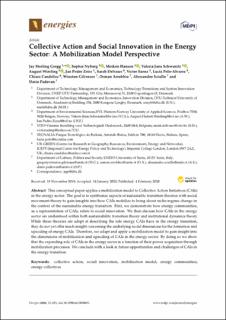| dc.contributor.author | Gregg, Jay | |
| dc.contributor.author | Nyborg, Sophie | |
| dc.contributor.author | Hansen, Meiken | |
| dc.contributor.author | Schwanitz, Valeria Jana | |
| dc.contributor.author | Wierling, August Hubert | |
| dc.contributor.author | Zeiss, Jan Pedro | |
| dc.contributor.author | Delvaux, Sarah | |
| dc.contributor.author | Saenz, Victor | |
| dc.contributor.author | Polo-Alvarez, Lucia | |
| dc.contributor.author | Candelise, Chiara | |
| dc.contributor.author | Gilcrease, Winston | |
| dc.contributor.author | Arrobbio, Osman | |
| dc.contributor.author | Sciullo, Alessandro | |
| dc.contributor.author | Padovan, Dario | |
| dc.date.accessioned | 2021-03-16T12:26:44Z | |
| dc.date.available | 2021-03-16T12:26:44Z | |
| dc.date.created | 2021-01-07T09:50:04Z | |
| dc.date.issued | 2020 | |
| dc.identifier.citation | Gregg, J. S., Nyborg, S., Hansen, M., Schwanitz, V. J., Wierling, A., Zeiss, J. P., . . . Padovan, D. (2020). Collective Action and Social Innovation in the Energy Sector: A Mobilization Model Perspective. Energies, 13 (3), 651. | en_US |
| dc.identifier.issn | 1996-1073 | |
| dc.identifier.uri | https://hdl.handle.net/11250/2733638 | |
| dc.description.abstract | This conceptual paper applies a mobilization model to Collective Action Initiatives (CAIs) in the energy sector. The goal is to synthesize aspects of sustainable transition theories with social movement theory to gain insights into how CAIs mobilize to bring about niche-regime change in the context of the sustainable energy transition. First, we demonstrate how energy communities, as a representation of CAIs, relate to social innovation. We then discuss how CAIs in the energy sector are understood within both sustainability transition theory and institutional dynamics theory. While these theories are adept at describing the role energy CAIs have in the energy transition, they do not yet offer much insight concerning the underlying social dimensions for the formation and upscaling of energy CAIs. Therefore, we adapt and apply a mobilization model to gain insight into the dimensions of mobilization and upscaling of CAIs in the energy sector. By doing so we show that the expanding role of CAIs in the energy sector is a function of their power acquisition through mobilization processes. We conclude with a look at future opportunities and challenges of CAIs in the energy transition. | en_US |
| dc.language.iso | eng | en_US |
| dc.publisher | MDPI | en_US |
| dc.rights | Navngivelse 4.0 Internasjonal | * |
| dc.rights.uri | http://creativecommons.org/licenses/by/4.0/deed.no | * |
| dc.title | Collective Action and Social Innovation in the Energy Sector: A Mobilization Model Perspective | en_US |
| dc.type | Journal article | en_US |
| dc.type | Peer reviewed | en_US |
| dc.description.version | publishedVersion | en_US |
| dc.rights.holder | © 2020 by the authors. | en_US |
| dc.source.volume | 13 | en_US |
| dc.source.journal | Energies | en_US |
| dc.source.issue | 3 | en_US |
| dc.identifier.doi | 10.3390/en13030651 | |
| dc.identifier.cristin | 1866776 | |
| dc.relation.project | EC/H2020/837722 | en_US |
| dc.source.articlenumber | 651 | en_US |
| cristin.ispublished | true | |
| cristin.fulltext | original | |
| cristin.qualitycode | 1 | |

